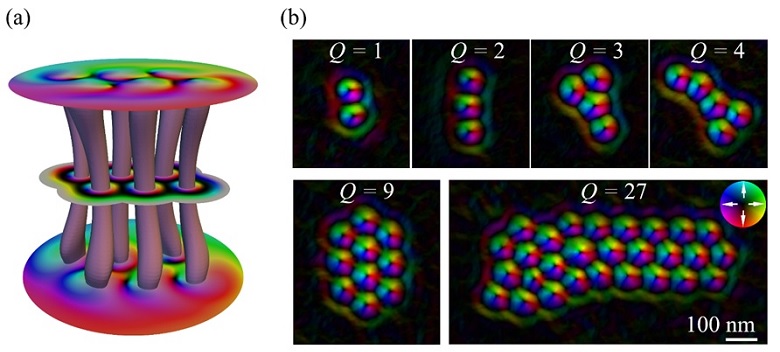In a study recently published in Nature Nanotechnology, a research group led by Prof. Du Haifeng and Dr. Tang Jin from High Magnetic Field Laboratory, Hefei Institutes of Physical Science (HFIPS), reported a scientific breakthrough after they found skyrmion bundles, a new family member of topological magnetic structures.
With the help of Lorentz transmission electron microscopy (Lorentz-TEM), the research group clarified, for the first time, a type of magnetic quasiparticles with arbitrary topological charges Q, and then further realized current driven dynamic motion of skyrmion bundles.
Skyrmion, a vortex-like localized chiral topological magnetic structure, has a potential to be the information carrier applied in future high-performance spintronic devices. The topological charge is a fundamental parameter of magnetic domains and determines their topology-related properties. Among the topological structures including skyrmions, merons, vortex, and skyrmion bubbles, the topological charges are both one or smaller than one. Although theory has proposed “skyrmion bags” and “high-order skyrmions” as multi-Q topological magnetic structures, their experimental observations remain elusive.
Using 3D micromagnetic simulation approach, the research group proposed a new 3D multi-Q topological structure, skyrmion bundle. Skyrmion bags persist in the interior of such magnetic objects and turn to multi-Q high-order skyrmions around the surface. Skyrmion bundles were then experimentally verified by Lorentz-TEM by reversing the field sign from initial skyrmion-helix mixed phases. Their current-driven dynamic motions were also further explored by in-situ TEM magnetic imaging. They found collective motions and topological sign dependence of Hall sideway shifts of skyrmion bundles driven by nanosecond pulsed currents.
Observation of skyrmion bundles in this study expands the charge of topological magnetic members from one to arbitrary integer values and sheds the diversity in topological magnetic zoo. Skyrmion bundles can serve as information carriers applied in distinct spintronic devices such as multi-state memory and information interconnect and should pave a new field of topological spintronics.
Figure 1 3D structure and experimental observation of skyrmion bundles.
